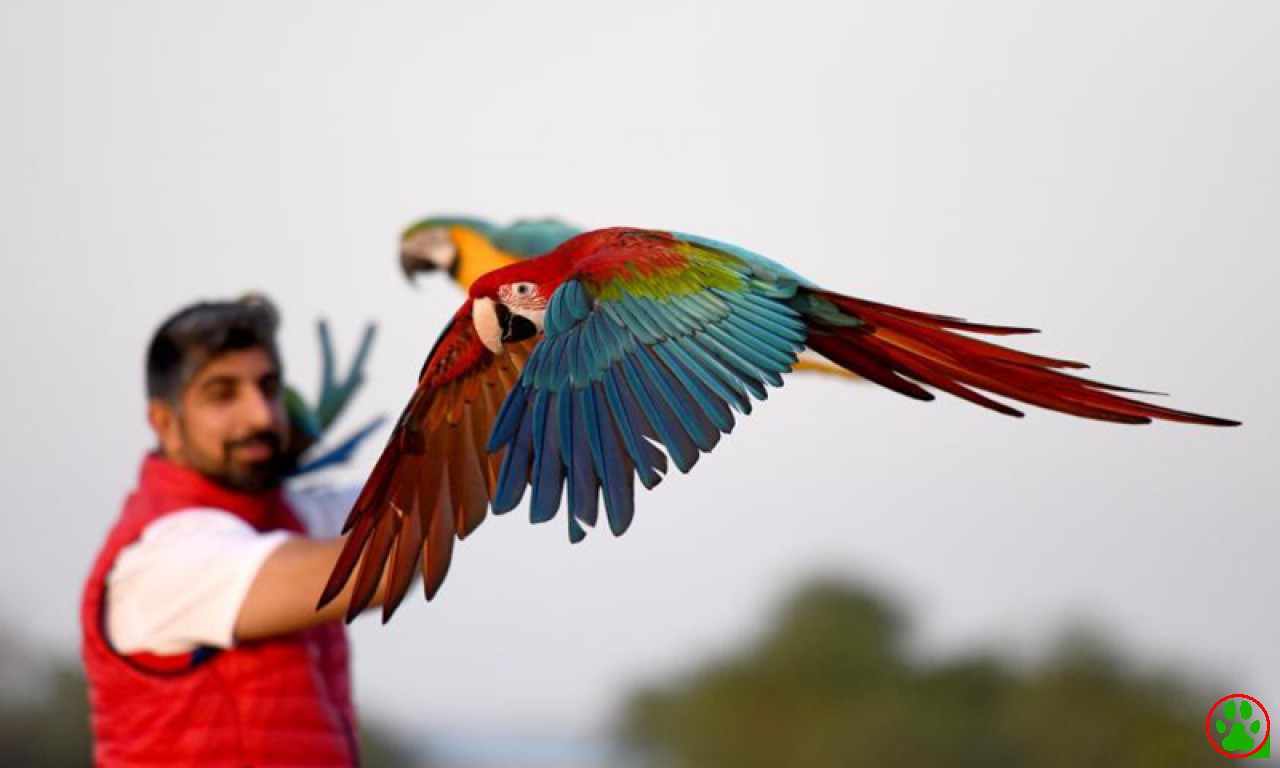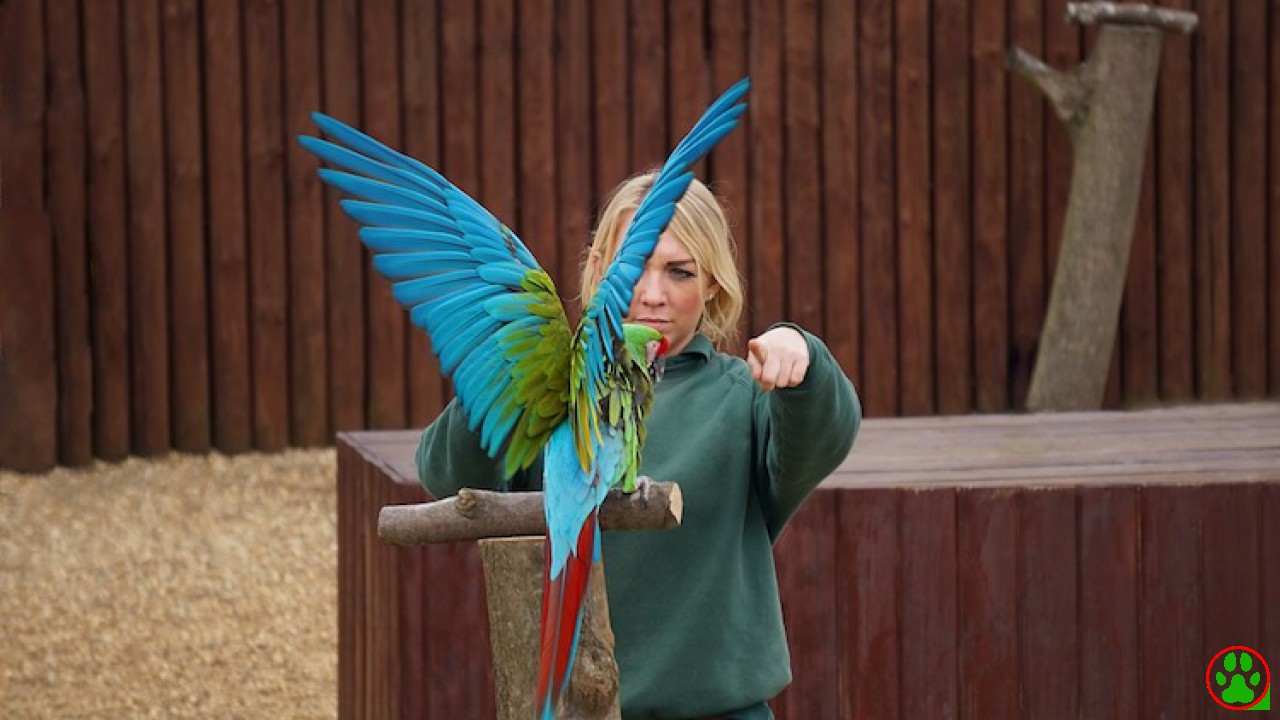How to Train a Parrot
How to Train a Parrot
Any parrot training plan, in essence, needs to be as individual as the bird you’ve welcomed into your home. Every parrot has a unique personality, and will require a particular mix of technique, patience, friendship, and bribery to be trained effectively. That said, there are some common tips that can help you prepare for training and — in most cases — teach some basic and useful skills.
1
Create a proper training environment. Think about how you would want to teach a small child. If they feel safe, calm, comfortable, and alert, they are more likely to take instruction effectively. The same is true for your parrot.
- Find a quiet space where you and your avian student can focus on the task at hand. Choose somewhere familiar to the bird so it will already have a level of comfort before training starts.
- Don’t try to train when the parrot is overly agitated. Wait for a calmer moment. However, training with treats works best when the bird is hungry, so training before mealtime is usually the best scenario.
2
Be prepared. While parrots are often quite friendly and caring, they are not in general known for being overly patient. Delays and mistakes during training sessions may not go over well, so preparation beforehand is important.
- Gather up the supplies you will need for they type of training you will be conducting. These might include items like a hand-held perch, a towel, a clicker (if “clicker training”), a chopstick or drumstick (if “target training”), a leash/harness (if taking training outdoors), bitter apple spray (to make common areas of parrot nibbling like draperies unappealing), and, of course, treats.
- Choose a treat that your parrot especially enjoys, and also that you can easily feed to your bird. Thin apple wedges, for example, can make a good hand treat for a parrot.
3
Start early, train often, but don’t push too hard. We’ve all heard that old dogs have trouble learning new tricks, and the same principle holds true for just about any animal, including parrots (and people, for that matter!).
- Begin the process of training your bird as soon as possible. So long as your parrot has reached the point of being capable (if not yet entirely willing) to eat a treat from your hand, you can begin training.
- Hold multiple training sessions during the day, ideally at similar times each day for consistency, but more importantly when the parrot is in the mood for learning (that is, calm).
- However, keep the sessions relatively short — no longer than fifteen minutes at a time. Once your bird begins to lose interest, it is best to end the session and begin again another time.
4
Have it eating out of your hand. Rewarding your bird with a treat from your hand is essential to practically every type of parrot training out there. It also helps establish a bond between you and a new and/or young parrot.
- Start the process with the parrot inside its cage. Slowly approach and present the treat. Stay calm and offer only encouraging approval when the bird eventually takes the treat.
- Apple slices, again, make a good treat option if you’re worried about having your fingers nibbled upon. You can also wear gloves, if you so choose, though your bird may find those even more appealing to peck at.
Part2
Using Basic Training Strategies
1
Shape the desired behaviors. “Shaping” is a training ideology that focuses upon rewarding the bird for approximations, and eventually deliberate acting, of the steps required to complete a training task.
- Shaping is well-named, for it is all about molding behaviors through positive reinforcement.
- As one example, if you were teaching your parrot to bathe itself in a small water dish, you would reward the bird for (among several other intermediary steps) looking toward the dish, looking at the dish, moving toward the dish, moving to the dish, testing the water, stepping into the water, and eventually splashing around.
2
Get your clicks. Pets ranging from birds to cats can often benefit from “clicker training,” which involves using a hand-held clicking device (think of the sound a pen clicker or metal juice-bottle cap makes) to indicate proper behavior worthy of a reward.
- The “click” serves as an audible cue that an appropriate response has occurred, and should occur immediately upon said response and be accompanied immediately by a reward. Thus, you may hear the phrase “click and treat” to describe what is essentially a single maneuver.
- For instance, if using a clicker during “step up training” — as detailed elsewhere in this article — the “click and treat” would occur immediately upon the parrot stepping up onto your finger/hand. Clicking can be incorporated into virtually any training program.
3
Stay on target. Another training option, which can be used in combination with a clicker if desired, is known as “target training.” It uses a bird’s natural curiosity in investigating new objects to build a reliable response.
- In a basic version of target training, a chopstick, drumstick, or other wooden wand is pointed in the vicinity of the parrot, and any contact with the tip is immediately rewarded with a treat (or “click and treat,” if desired). Slowly, over time, the parrot will learn to follow the target throughout the cage and around the room, in the process learning to obey a simple command prompt.
- Target training builds a key basic skill, therefore, that serves as a gateway to more specific training.
Part3
Trying Variations of the “Step Up”
1
Employ the “step up” as an early training step. As the name indicates, this skill involves your bird learning to step or hop from one perch to another as directed, with the target perch usually your hand, finger, or hand-held perch (such as a dowel rod).
- The step up is an ideal skill to teach early on for several reasons:
- It is relatively easy to master for both teacher and student.
- It derives from a natural parrot behavior, the desire to move from perch to perch.
- It is practical, as having your bird hop into your hand on command makes everything from playtime to cage-cleaning easier.
- It leads into other, more detailed skills as a basic maneuver.
- While the step up is a simple skill, there are numerous training methods of varying complexity from which to choose, a few of which are described in the following steps.
2
Test the most basic method. If your new bird has some prior training experience or just a natural inclination, the simplest training option may be sufficient.
- Offer your finger or wrist to your parrot (depending on the bird’s size and your preference), placing it in front of the bird at mid-breast level. Many birds will naturally step up onto the new perch without any coaching at all.
- Create a cue for the behavior, either by saying “step up” or employing a clicker simultaneous to the parrot making its move. Reward the bird immediately as well.
- If the bird does not step up unprompted, employ “shaping” and reward incremental behaviors, such as touching the perch with the beak, placing one foot on the perch, etc.
3
Use an alternate treat-based step-up. In this method, you use the treat more as a lure to coax the desired behavior, but the basic training principles are quite similar.
- Hold the treat in one hand, and offer the other hand/finger to the bird at chest level. Orient your hands so that the easiest way for the parrot to reach the treat is by stepping up onto the offered perch.
- If your bird does not immediately step up, reward any contact with the offered perch at first, and incrementally reward only the desired step-up behavior.
- If you’re handy enough with the clicker to use it while both hands are occupied, it can be incorporated, and/or a verbal cue like saying “step up.”
4
Move on to the target-training step-up. If other methods have been less successful, or you have been utilizing target training already, you can teach the step-up by employing the familiar target and reward system.
- Hold your familiar target — a wooden drumstick, for instance — in one hand, and your desired perch (your finger, hand, or hand-held perch) in the other. Alternatively, if your manual dexterity is up to the task, you can do both with one hand, which leaves the other for holding treats, a clicker, etc.
- Locate the target so that it directs the bird to the new perch, which should be located in the common step-up position at the bird’s chest.
- Immediately reward positive behavior, and use the clicker or a verbal cue if desired. Eventually, the target will no longer be required to prompt the behavior.
Part4
Teaching Your Parrot to Talk
1
Don’t presume your parrot will (or won’t) talk. Especially for people new to parrot ownership, talking is usually the first skill they think of teaching and of which they presume their bird will be able to master.
- The truth of the matter is, every parrot is different, and you should never acquire a bird — even of a breed known for talking — with the assumption that it will talk.
2
Watch your mouth. Some parrots will require little or no training to learn to talk, and may in fact pick up words and phrases you’d prefer they not repeat.
- Excited utterances — such as things you might shout at the TV during a sporting event — are often more readily picked up by a parrot, and they’re listening more often than you may think. So be careful what you say around them!
3
Start young and stay calm. Parrots talk to other members of their flock, and it is easier to establish yourself as part of your bird's flock early in its life. Therefore, you are more likely to have success when starting with a baby bird.
- Use a clear, calm, happy voice to repeat a simple word or phrase as you start the training process. Think about how you would try to teach a human child to say "Mommy."
- Early in the process, reward any sound, then any approximately accurate sound, and eventually a recognizable sound with an immediate treat.
4
Repeat, and repeat again. Repetition is the key element of training a parrot to talk. Simply put, the more times you say a word or phrase around a parrot, the more likely it is to pick it up and repeat it.
- Train as often as you like. Parrots will not tire of conversing with another member of their flock, although you may.
- Some experts recommend recording yourself saying a phrase and playing it back on a loop for the bird. Of course, by using this method you lose the personal interaction between the two of you.
source : wikihow

















